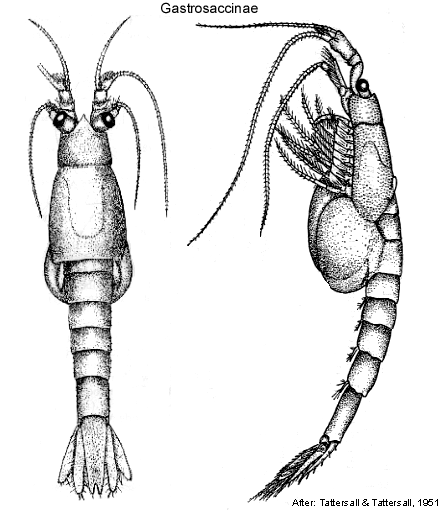 |
||||||
|
|
|
|
|
|
Mysidacea: Families, Subfamilies and TribesKenneth MelandGastrosaccinae Norman, 1892 Diagnostic description. Head. Carapace large, last 2 or 3 thoracic somites exposed dorsally. Rostrum obtuse. Eyes normally developed. Antenna (antenna 2) scale with apical suture, outer margin smooth, without setae, with terminal spine. Labrum produced anteriorly. Mandible lacinia mobilis well developed, spine row absent (in genus Gastrosaccus) or spine row present between lacinia mobilis and molar process, molar process well developed. Thorax. 1st maxilliped exopod well developed (and in Anchialina the 1st maxilliped bears a small claw). 2nd thoracopod developed as a maxilliped (and in Gastrosaccus supports a small claw), exopod well developed. 3rd-8th thoracopods endopod with distinct carpus and propodus (e.g. Anchialina) or endopod with fused carpus and propodus (tarsus) (e.g. Gastrosaccus), carpopropodus segmentation increases posteriorly (Gastrosaccus), propodus segmentation increases posteriorly (Anchialina). Branchiae on thoracopods absent. Marsupium composed of two pairs of oostegites, or composed of three pairs of oostegites. Abdomen Abdomen pleural plates absent, or female pleural plate 1 well developed, partially covering marsupium. 6th & 7th abdominal somites fused. 1st pair biramous, or endopod reduced (in Anchialina); 2nd pair biramous; 3rd pair exopod elongated (in some Gastrosaccus species the endopod is reduced or fused to the exopod); 4th pair biramous; 5th pair biramous. Female pleopods 1st pleopod biramous, remaining reduced (reduced to uniramous unsegmented plates). Uropod endopod inner margin with robust setae, statocyst present; exopod complete, outer margin with robust setae. Telson apex cleft. Generic composition. Gastrosaccinae continas 8 genera (96 species): Anchialina Norman & Scott, 1906 (17 species); Archaeomysis Czerniavsky, 1882 (6 species); Bowmaniella Bacescu, 1968 (15 species); Gastrosaccus Normann, 1868 (22 species); Haplostylus Bacescu, 1973 (25 species); Iiella Bacescu, 1968 (8 species); Paranchialina Hansen, 1910 (2 species); Pseudanchialina Hansen, 1910 (2 species). Remarks. The Gastrosaccinae are hyperbenthic mysids, and with the exception of the genus Anchialina which generally prefer deeper waters, are found inhabiting coastal and littoral waters throughout the world. Due to the characteristic ventral extension of the first abdominal somite seen in females the Gastrosaccinae they are easily distinguished from the remaining mysids. Good descriptions and recent additions to the Anchialina, Gastrosaccus, and Haplostylus can be found in Panampunnayil (1997, 1999). For a review of the Archaeomysis see Hanamura, 1997.
Cite this publication as: 'Meland, K. (2002 onwards). Mysidacea: Families, Subfamilies and Tribes. Version 1: 2 October 2002. https://crustacea.net'. |
|
|
|
|
|
|
|
|
|
Copyright © Australian Museum, 2002 - 2003
Australian Museum website
